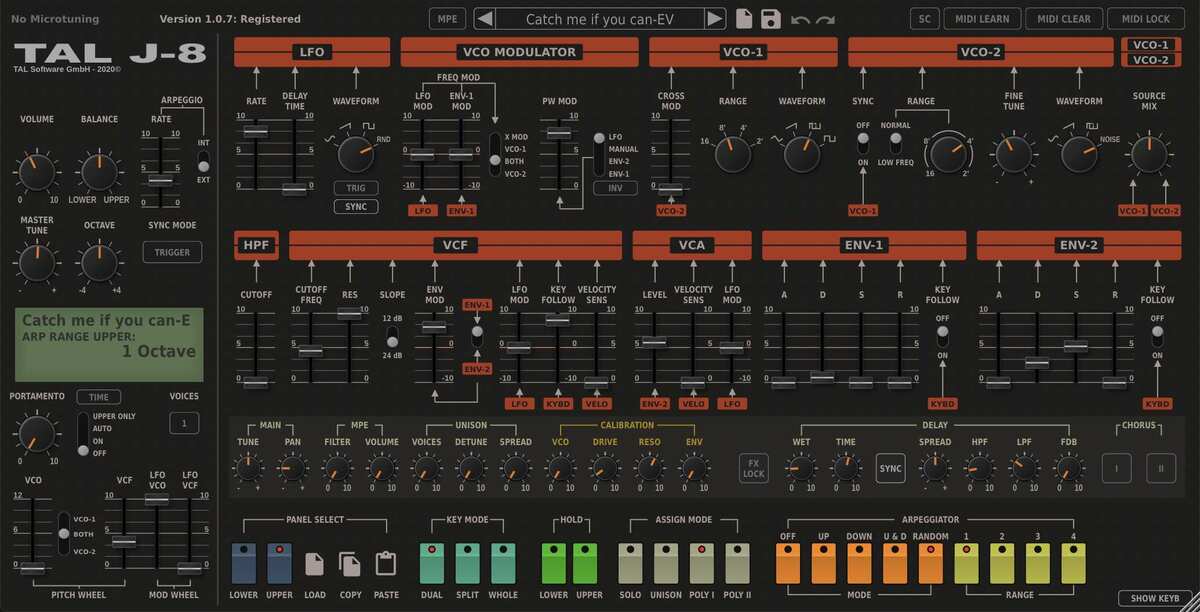Loopy Pro: Create music, your way.
What is Loopy Pro? — Loopy Pro is a powerful, flexible, and intuitive live looper, sampler, clip launcher and DAW for iPhone and iPad. At its core, it allows you to record and layer sounds in real-time to create complex musical arrangements. But it doesn’t stop there—Loopy Pro offers advanced tools to customize your workflow, build dynamic performance setups, and create a seamless connection between instruments, effects, and external gear.
Use it for live looping, sequencing, arranging, mixing, and much more. Whether you're a live performer, a producer, or just experimenting with sound, Loopy Pro helps you take control of your creative process.
Download on the App StoreLoopy Pro is your all-in-one musical toolkit. Try it for free today.




Comments
Nice! I really hope the Juno did well enough for them to make this (and the Sampler) available in iOS.
Edit: I see that they haven't announced it in their news feed or twitter so I'm taking that as evidence that they're waiting for it to be approved by Apple
I hope so! That'd be sweet. Another winner by Tal.
I use TAL UNO LX all the time! And love it. I so hope this gets ported to iOS. I might have to buy this in support. I had desktop UNO LX for years but on iOS, it's been magic.
Off to download the desktop demo now 😊
First mini impression...
Cannot post audio demos here but it sounds great!!
.
Oooh....hope this comes to the iOS world...love TAL-U-NO-LX tons
Hmmm...it has native Apple M1 support...nice. Not that I have a Mac M1 but it’s nice to know 👍🏽
I pinged the dev on Twitter asking about an iPadOS port 🤞🏼
this would be amazing. the more i jam on synths the more i dig these simpler, classic synths for everyday use. tal-u-no-lx and obx are top ten ups synths for me. i think zeeon will always be #1
One of my favorite vintage synths.
Would be really cool to have for iPad.
I'd think they'd sell really well.
Everyone should ping the dev on Twitter or via their site 😉
Can anyone hep me to what is special about the JUpiter-8. I wasn’t paying much attention to synths when it was around.
I would like Fantom on iOS
First mini impression...> @espiegel123 said:
The sound.
It's a bit like with the Arp Osyssei: Simple controls but exceptional results.
Try the demo version on your desktop machine. It has extremely loud noise swells every minute which goes over the top IMHO but you can browse through the presets nonetheless. Sync, PWM, RM, the filter, the fat sound overall and an inviting UI.
Dave Spiers from GForce has done one of the best Jupiter-8 demos I've seen:

It was a really modern sounding reliable synth (14bit version) when it was released that had a much tighter sound than the Jupiter 4.
I actually think it’s overrated and hate the sync sounds it’s famous for.
Jupiter 6 is my favourite. Has that woody thing like the 101. 🙂
IMO.... Back in it's day it was something of an engineering masterpiece. I'd call it the pinnacle of classic "primary wave-form based oscillator", subtractive synth design. It packed the broadest range of programing options into an extremely easy to understand, intuitive, programing interface.
It sort of like car guys who go nuts over the best engineering masterpiece cars of the mid to late 60's. Cars (in the USA) like the Shelby mustang, or the Pontiac GTO. They were cars that took old school automotive engineering and took it to the limits of optimization. They were beautiful both as cars and as optimal engineering designs. When the 70's brought mandated emissions controls, it altered car designs from the category of high function minimalism, and added complex design elements that detracted from that minimalism.
I'd compare the Jupiter 8 being for a vintage synth enthusiast. as a 1965 Shelby mustang is for a vintage car enthusiast.
IMO.. the Jupiter 8 was the perfection at the very end of an era. Because the next synths that came afterward began to omit the hands-on controller sliders and knobs, and began switching to computerized LED display parameter based programing that was really non-intuitive. (They started to sell controller interfaces with the sliders and knobs as optional add-on accessories, and they were costly).
IMO.. the Jupiter 8 was a subtractive synth, and limited to sounds in the subtractive synth sound genre . But it was the design that offered the broadest palate of subtractive synth sound creation capabilities, in the era when subtractive synths were at the height of popularity, and at the end of their run.
The existing TAL U-NO-LX is another example. It's an easy to understand synth, and one I think most beginners could use to learn subtractive synthesis with.
Someone with a good grasp of programing the TAL U-NO, and likes that synth. Would probibly find the TAL J-8 very familiar, and be blown away by the extra OSC's, ENV's and abundance of features the TAL J-8 provides using the same intuitive general type of "interface design", as the TAL U-NO.
this!

Patrick answered my email: sadly they don't have any plans to make this available for ipads.
Oh that's a bummer! Thanks for asking him.
Sooner or later, another iOS developer might do it 😉
The tone regarding iOS/iPadOS port of TAL-UN-O-LX was negative for a very long time until it finally popped up
Don't know if the sales have been too low to motivate him to bring the rest of the apps to iOS/iPadOS?
Cheers!
I understand this is a magical synth that has earned a fond place in many people’s hearts. But why do you need it on ipad? Just build it in Drambo 🤷♂️
I’d be likely putting it through woot or something, so these recreations of subtle minute details in oscillators or whatever, seem like a waste on people like me.
Of course I appreciate you guys finer attention for detail, and I’m clearly jealous of your skills, so maybe I’ll just shut up now
Although I'm very much a promoter of this concept, sometimes it's simply easier to pay $10 or 15 and get a proper emulation with a nice UI and good presets rather than spending days or even weeks to get there with your own project. I've started to build a Prophet 5 clone in Drambo and the prototype worked very well but I haven't found the time to finish it yet (and make a proper flexible synth out of it including mode switches and routings) and at some point it can be a good idea to spend your time with more lovely things in life 😉
It's also a lot of work to emulate filters that don't sound like the originals out of the box.
Are Drambo’s oscillators capable of getting satisfyingly analog-like fat tones?
Oh yes!
The trick is to either use the Graphic Shaper as an audio-rate wave shaper to get the exact same waveform as the original (make sure you disable OSC anti-aliasing in that case!), or record a number of oscillator waveforms directly from the original and build a wavetable from it, like done in the factory wavetables "Prophet Saw" or "SH101 Square".
If we had some sensor modules we could even subtly modulate some parameters with temperature, humidity, air pressure, to better recreate the real thing.
I’m just kidding, please don’t hate me for this 🙏
Maybe if they get enough mail they will change their mind. I sent my request.
Drambo is not the solution to everything
Jazz flutist Paul Horn did an entire vinyl album with Ralph Dyck playing the Jupiter 8 and partially composed with the MC-4 Microcomposer.